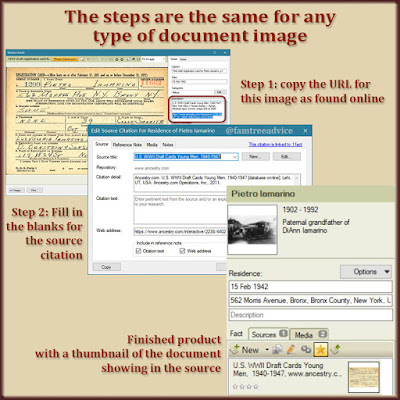I thought Grandpa skipped draft registration due to his birth date. Wrong!
I used to wonder why I never found a draft registration card for my Grandpa Iamarino. He arrived in America in 1920 at the age of 18. He should have had to register like all the other old men in my family.
Then I realized Grandpa was lucky. Born in late 1902, Grandpa was too young to have been called to serve in the Italian military. (My other grandfather served several times, fought in World War I, and was held prisoner for a full year.)
And the U.S. World War II draft registration in 1942 left out Grandpa, too. It covered men born on or between 28 April 1877 and 16 February 1897. Grandpa was too young again. What a lucky guy!
Then I found a surprise. While searching Ancestry.com for Grandpa's naturalization papers I saw something new. It was Grandpa's "Young Men's" draft card. This had never shown up before.
Grandpa was 39 years old and in good health when he registered. He had a wife and 2 children. The U.S. never called him to serve, but boy am I glad they registered him. This type of registration covered all men born on or between 17 Feb 1897 and 31 Dec 1921. It says so at the top of the card. The "old man's" draft registration card has the dates at the top, too.
 |
| Each registration has a birth date range. Is your ancestor out of range? |
This new-to-me card had 3 important facts:
- My grandmother had a middle name! I saw her listed once as Lucy G. Iamarino. My dad says that rang a bell, but he didn't know what the G stood for. At long last I know her middle name was Gloria. Like my favorite U2 song.
- Grandpa worked for D. Ornstein and Sons, Inc. at 119 West 24th Street in New York City. Grandpa was a jeweler. A stone setter. I always assumed he worked in the Bronx, close to home. But Grandpa commuted downtown.
- Grandpa's signature in 1942 doesn't quite match his signature in 1952. A 1952 index card is something Grandpa needed to prove his citizenship when he moved to Ohio. His signature in 1952 looks shockingly like my dad's signature. There are circles over the I's. I asked my father if he could possibly have signed it, but he said no. As I compare the 1942 and 1952 signatures, I see that the circles over the I's are the only real difference. Was that in style at the time, or did he see his son's signature and think it was more American? Now I know my dad did not sign Grandpa's official card.
Earlier this week I published a fill-in-the-blanks PDF for that lets you create a 5-generation ancestry chart for anyone. One reader suggested I make a form for U.S. draft registration cards. So here they are. Download these files and you can type any ancestor's information into the form, then save the file with their name. Typing is so much better than printing!
- World War I draft registration card Note: Now revised to include all 3 types of cards
- World War II young men's draft registration card
- World War II old men's draft registration card
If you have an idea for another useful form, please let me know. Here's what I have so far.









